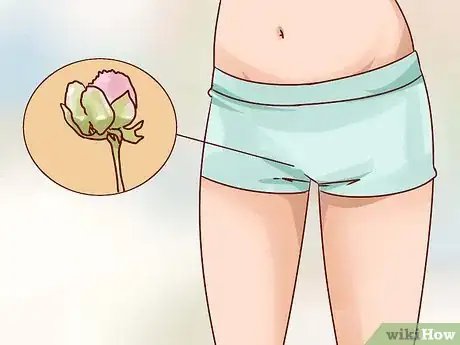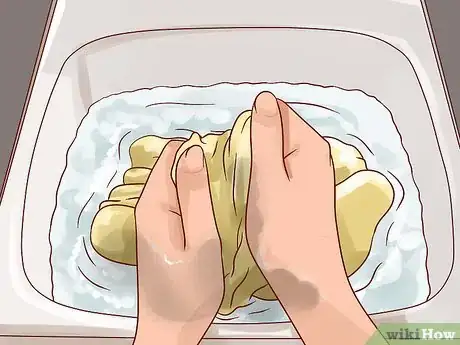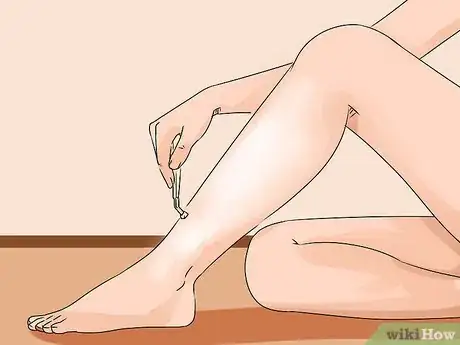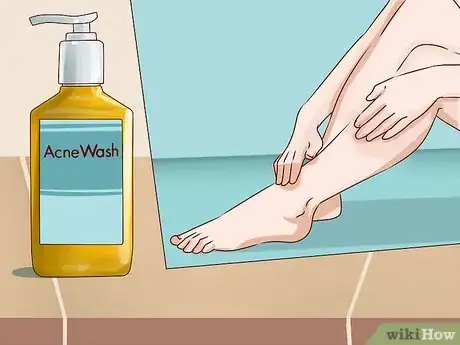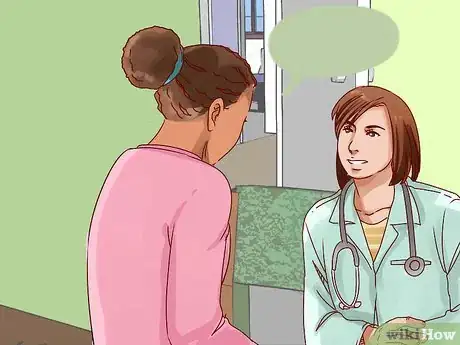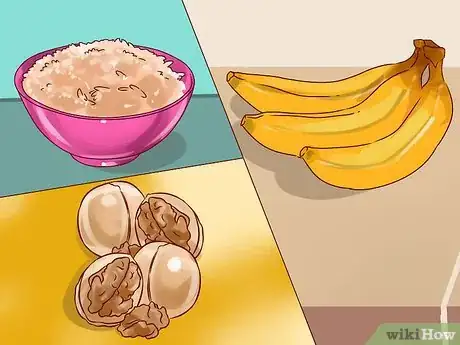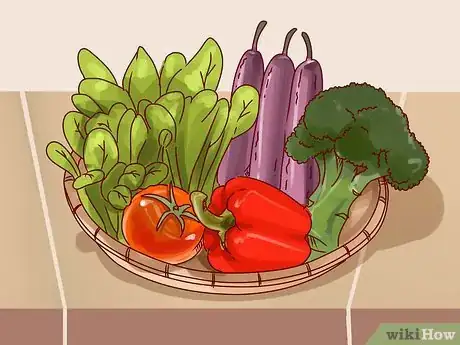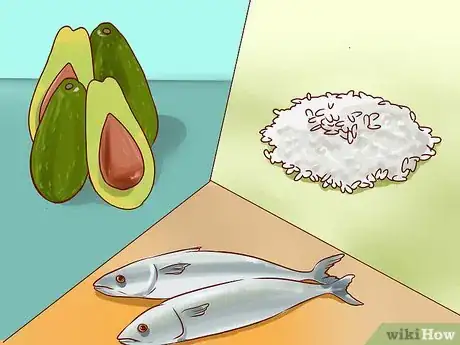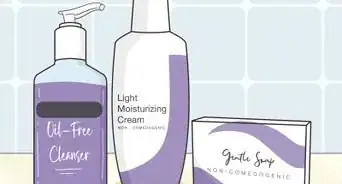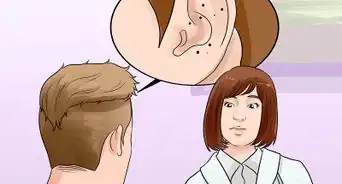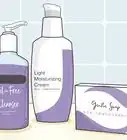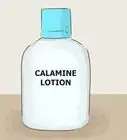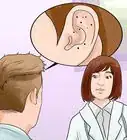This article was co-authored by Laura Marusinec, MD. Dr. Marusinec is a board certified Pediatrician at the Children's Hospital of Wisconsin, where she is on the Clinical Practice Council. She received her M.D. from the Medical College of Wisconsin School of Medicine in 1995 and completed her residency at the Medical College of Wisconsin in Pediatrics in 1998. She is a member of the American Medical Writers Association and the Society for Pediatric Urgent Care.
There are 18 references cited in this article, which can be found at the bottom of the page.
This article has been viewed 109,804 times.
Acne is the most common skin condition among adults in the US. Leg acne is somewhat less common than on other parts of the body, such as the chest and face, but it can be a problem. Leg acne is a little different than usual acne. It is usually caused by folliculitis, dermatitis, ingrown hairs, allergic reactions, or keratosis pilaris instead of true acne. Despite this, it can usually be treated similar to normal acne. Leg acne can occur at any age and is often accompanied by acne on the buttocks. If you have problems with leg acne, there are ways you help get rid of it.
Steps
Treating Leg Acne With Home Remedies
-
1Bathe daily to remove pore-clogging impurities. To help reduce leg acne, shower often. Aim for once every day. Bathing removes bacteria, dirt, and sweat from your skin.
- If you sweat a lot, for example after a workout, you should take an extra shower afterwards. Legs can be prone to sweating during physical activities.
- Use a gentle product. Use products labeled as noncomedogenic. This means it won't promote the formation of acne. If your leg acne has larger pimples and bumps, you may want to try using an antibacterial cleanser.
- Consider an exfoliating product or using a loofah once or twice a week.
- Try products from brands like Neutrogena, Cetaphil, and Olay.[1]
-
2Try essential oils to treat acne. Herbal oils may be effective to spot treat acne on your legs. These essential oils have antibacterial and antiseptic properties. Herbal oils may help new pimples from forming and help pimples heal. They can also help dissolve the oil that clogs up the pores.
- Try spearmint, peppermint,[2] , calendula[3] , lavender[4] , or tea tree oil.[5]
- Always combine the essential oil with a carrier oil. Try camphor, mineral oil, castor oil, almond oil, avocado oil, olive oil, peanut oil, hazelnut oil, apricot kernel oil, safflower oil, grape seed oil, hemp seed oil, and evening primrose oil.
- Mix 10 drops of the essential oil for every ounce of carrier oil.[6] [7] Dab the mixture on any problem areas.
- Always test the essential oil for sensitivity on your skin. Add a drop of the essential oil diluted in water to your skin. Wait for about an hour. If you have no reaction, use the oil.
Advertisement -
3Take a sea salt bath to treat acne. Sea salt is great to treat acne. It cleans the area and helps eliminate the acne-causing bacteria.[8] Sea salt works as an exfoliant, which means it helps get rid of impurities and dead skin.[9]
- Sea salt baths can be especially effective for your legs since you can soak your legs in the bath water.
- Begin filling your tub with hot water. Add a cup of sea salt to the running water. This will help it dissolve more easily. Soak your legs for at least 10 to 15 minutes.
- You can also add about three to five drops of an acne-fighting essential oil, such as lavender, spearmint, peppermint, or tea tree oil.
-
4Wear clothing that breathes to avoid trapping bacteria. Leg acne can occur when you sweat in clothing that doesn't breathe. Excessive sweating or sweat trapped against the skin of your legs can make acne worse or give your breakouts.[10] [11]
- Wearing cotton underwear, shorts, or pants helps the sweat evaporate better.
- Avoid wearing non-breathable fabrics, such as polyester.
- If you work out a lot, make sure you wear cotton or other breathable fabrics. You may also consider fabrics with moisture wick technology. Change your clothes immediately after sweating a lot. Don't wear workout clothes multiple times without washing them if you sweat a lot.
-
5Wash your clothes often to remove acne-causing dirt and oils. To reduce leg acne, wash shorts and pants on a regular basis. Sweat and dirt on the clothing can cause pimples.[12]
- Make sure to wash your clothes after wearing them, especially after a workout or other physical activity.
- If you also have trouble with acne on your buttock area, make sure to change your underwear daily.
- You should also wash your sheets often, preferably once a week.
-
6Switch to fragrance and dye-free hygiene products. Leg acne can occur as a result to something in the products you are using.[13] Some of the additives in skin care products, cleansing products, or fragrances can cause breakouts, especially if you have sensitive skin. These additives include formaldehyde, neomycin, nickle, and even soy.
- Use body wash, soaps, and lotions with less fragrances or additives. Look for products specifically for sensitive skin.
- You may also consider using a laundry detergent with fewer dyes and no fragrance.
-
7Use proper shaving techniques. If you find your legs break out after you shave them, make sure you are using proper, hygienic techniques. Some things to try include using a clean, sharp razor; using shaving cream to soften the hair; shaving with the the growth of your hair, not against; and shaving your legs at the end of your shower, when hair has been softened by the water.
Treating Leg Acne With Acne Medication
-
1Use acne cleansers to prevent and heal acne. A way you can treat your leg acne is to use an acne prevention or treatment cleanser. An acne cleansing wash contains acne-fighting medication to help heal and prevent pimples.[14]
- You can find many acne body washes and soaps available to buy. If you cannot find one, you can try a wash for facial acne on your legs.
- Make sure the cleanser has benzoyl peroxide, salicylic acid, or alpha hydroxy acids.
- If you have sensitive skin, use a 2.5% concentration of benzoyl peroxide or lower.
-
2Try acne creams to treat acne. Many creams and spot treatments are aimed to help prevent and treat acne. These creams are supposed to be used directly on the pimple, or smeared over the area with a high concentration of acne. Many of these creams and spot treatments have a higher concentration of medication.
- Most creams or spot treatments will not be labeled for use on the legs; however, any acne product for the body can be used on your legs.
- Make sure the creams or spot treatments have benzoyl peroxide, salicylic acid, or alpha hydroxy acids. Benzoyl peroxide is usually the most effective over-the-counter product for leg acne.
- If over-the-counter creams don't work, your doctor may prescribe stronger ointments, including antibiotic ointments.
- You can try acne creams, acne pads to wipe across on your legs, or other spot treatments.
-
3Visit your doctor if no treatment heals the acne. Most people will see a reduction of their leg acne within a few weeks. If you see no improvements in your leg acne within a few weeks, make an appointment with your dermatologist to explore other medications or approaches that may be needed.
- Although this may seem slow, you can't rush the healing process. Trying to rush it may cause scarring or make your skin worse.
- Your dermatologist may prescribe stronger medication for you. Topical treatments include retinoids and antibiotics, while common oral treatments include antibiotics, oral contraceptives, an anti-androgen agent, and isotretinoin.[15]
Eating Foods To Help With Acne
-
1Eat foods with a low low-glycemic index (GI) to reduce acne. Since bacteria love sugar, you want to limit the amount of sugar you eat. Studies have indicated that foods with a low GI can reduce the severity of acne. These low GI foods release sugars slowly into your blood. Low GI foods include:[16]
- Most vegetables, except beetroots, pumpkin and parsnips
- Nuts
- Most fruit, except watermelon and dates. Mango, banana, papaya, pineapple, raisins, and figs have medium GI.
- Whole wheat, pumpernickel, whole grain breads
- Bran cereals, Natural Muesli, rolled oats
- Brown rice, barley, whole grain pasta
- Legumes
- Yogurt
-
2Add more Vitamin D for your skin's health. Vitamin D promotes healthy skin. The most efficient way to get Vitamin D is to go out into the sun for 10 to 15 minutes a day. Sunlight triggers the skin's production of Vitamin D. When going out into the sun for longer than that, protect your skin from harmful UV rays with sunblock.[17] [18]
- Vitamin D can also be absorbed from food. Vitamin D can be found in fish and cod liver oil, and dairy, like milk, yogurt, and cheese. Many foods are fortified with vitamin D.
-
3Incorporate skin-healthy foods that contain in Vitamin A. Vitamin A is very important for skin health. Keeping your skin healthy can help reduce the risk of acne. Foods high in Vitamin A include:[19]
- Vegetables like carrots, spinach, pumpkin, red peppers, sweet potato, broccoli, summer squash
- Fruit like mangoes, cantaloupe, apricots
- Legumes
- Meat and fish
-
4Eat more omega-3 fatty acids to reduce oil-causing molecules. Foods high in omega-3 fats can help those with acne. Omega-3s are believed to help control molecules in the body that produce oil and cause acne. Omega-3 fatty acids are found in:[20]
- Avocados
- Vegetables, like spinach, sprouted radish seeds, and chinese broccoli
- Fish , like salmon, sardines, mackerel, whitefish, and shad
- Seeds and nuts, like flaxseeds and flaxseed oil, chia seeds, butternuts, and walnuts
- Herbs and spices, like basil, oregano, cloves, and marjoram
Expert Q&A
-
QuestionWhat if your acne gets better but doesn't go away completely and, after a while, starts developing again?
 Laura Marusinec, MDDr. Marusinec is a board certified Pediatrician at the Children's Hospital of Wisconsin, where she is on the Clinical Practice Council. She received her M.D. from the Medical College of Wisconsin School of Medicine in 1995 and completed her residency at the Medical College of Wisconsin in Pediatrics in 1998. She is a member of the American Medical Writers Association and the Society for Pediatric Urgent Care.
Laura Marusinec, MDDr. Marusinec is a board certified Pediatrician at the Children's Hospital of Wisconsin, where she is on the Clinical Practice Council. She received her M.D. from the Medical College of Wisconsin School of Medicine in 1995 and completed her residency at the Medical College of Wisconsin in Pediatrics in 1998. She is a member of the American Medical Writers Association and the Society for Pediatric Urgent Care.
Board Certified Pediatrician If certain products were helping, then you should consider using them regularly. You may not need to use them every day, but maybe a few times per week. Think about what else could be triggering your acne, such as sunlight, food, sweating, etc. Talk to your doctor if you can't get your acne under control after trying the steps in this article
If certain products were helping, then you should consider using them regularly. You may not need to use them every day, but maybe a few times per week. Think about what else could be triggering your acne, such as sunlight, food, sweating, etc. Talk to your doctor if you can't get your acne under control after trying the steps in this article
References
- ↑ Leyden JJ. A review of the use of combination therapies for the treatment of acne vulgaris. Journal of the American Academy of Dermatology. 2003 Sep 30;49(3):S200-10.
- ↑ Kamatou GP, Vermaak I, Viljoen AM, Lawrence BM.Menthol: a simple monoterpene with remarkable biological properties. Phytochemistry. 2013 Dec;96:15-25.
- ↑ http://www.ncbi.nlm.nih.gov/pubmed/20175810
- ↑ Kasper S. An orally administered lavandula oil preparation (Silexan) for anxiety disorder and related conditions: an evidence based review. Int J Psychiatry Clin Pract. 2013 Nov;17 Suppl 1:15-22.
- ↑ Enshaieh S, Jooya A, Siadat AH, Iraji F. The efficacy of 5% topical tea tree oil gel in mild to moderate acne vulgaris: a randomized, double-blind placebo-controlled study. Indian Journal of Dermatology, Venereology, and Leprology. 2007 Jan 1;73(1):22.
- ↑ http://www.foxnews.com/health/2013/09/18/5-essential-oils-that-heal.html
- ↑ http://www.healthyandnaturalworld.com/best-essential-oils-for-acne/
- ↑ http://www.onegreenplanet.org/natural-health/how-to-use-sea-salt-water-to-treat-acne/
- ↑ http://homeremediesforlife.com/sea-salt-for-acne/
- ↑ Holland KT, Ingham E, Cunliffe WJ. A review the microbiology of acne. Journal of Applied Bacteriology. 1981 Oct 1;51(2):195-215.
- ↑ http://www.npr.org/blogs/health/2014/09/05/346055067/stinky-t-shirt-bacteria-love-polyester-in-a-special-way
- ↑ https://www.aad.org/public/everyday-care/skin-care-secrets/routine/prevent-summer-skin-problems
- ↑ https://www.aad.org/public/everyday-care/skin-care-secrets/routine/prevent-summer-skin-problems
- ↑ Leyden JJ. A review of the use of combination therapies for the treatment of acne vulgaris. Journal of the American Academy of Dermatology. 2003 Sep 30;49(3):S200-10.
- ↑ http://www.mayoclinic.org/diseases-conditions/acne/basics/treatment/con-20020580
- ↑ http://ajcn.nutrition.org/content/86/1/107.full
- ↑ https://www.nlm.nih.gov/medlineplus/ency/article/002405.htm
- ↑ https://ods.od.nih.gov/factsheets/VitaminD-HealthProfessional/
- ↑ https://ods.od.nih.gov/factsheets/VitaminA-HealthProfessional/
- ↑ http://www.webmd.com/skin-problems-and-treatments/acne/features/lifestyle?page=2
About This Article
Having acne on your legs can be frustrating, but by keeping your skin clean and using simple natural remedies, you can start clearing up your breakouts. Remember to take a shower every day, which will help remove bacteria, dirt, and sweat that can clog your pores. Alternatively, take a bath with sea salt in it, which can help exfoliate your skin and get rid of impurities in your pores. You can also try rubbing an essential oil, like spearmint, lavender, or tea tree oil, on your acne, which can help dissolve the oil in your pores. While your acne heals, wear loose, cotton underwear that will help your skin breathe and avoid trapping bacteria in your skin. For more tips from our Medical co-author, including how to improve your acne by eating certain foods, read on!



